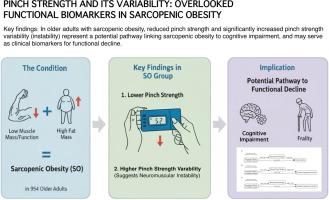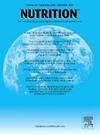捏紧强度及其可变性:对肌肉减少性肥胖的功能下降的新见解
IF 3
3区 医学
Q2 NUTRITION & DIETETICS
引用次数: 0
摘要
目的肌少性肥胖(SO)是一种与不良健康结果相关的复杂营养状态,尤其是在老年人中。虽然握力与功能状态的关系已被广泛研究,但捏紧强度的作用仍未得到充分探讨。本研究旨在探讨捏捏强度参数与不同身体成分表型之间的关系,并探讨其在SO与功能状态(包括身体表现、认知功能和虚弱)之间的潜在作用。方法本横断面研究纳入954名社区居住老年人,分为四组:健康对照组(HC)、肥胖组、肌肉减少组和肥胖组。我们通过生物电阻抗分析、肌肉力量(握力和捏力测量)、身体表现、认知功能和虚弱程度来评估身体成分。通过性别分层的相关网络和中介分析来阐明身体成分、肌肉力量参数和功能状态之间的关系。结果与HC组和肥胖组相比,SO组和肌肉减少症组的捏握强度明显降低(例如,女性:SO组为2.2±0.8 kg, HC组为3.5±1.1 kg, P < 0.001),捏握比更高(0.20-0.25比0.15-0.20,P < 0.05)。值得注意的是,SO组在男性和女性中都表现出更大的捏紧强度变异性(变异系数)(女性CV: SO组18.5% vs. HC组12.1%,P < 0.001),表明精细运动功能的神经肌肉控制受损。SO组功能表现最差。中介分析表明,捏捏强度是SO与认知障碍之间的重要中介,在女性中,捏捏强度是SO与认知障碍之间的重要中介,在女性中,捏捏强度与虚弱之间存在部分关联(间接效应log-OR =−0.07,95% CI[−0.12,−0.03])。结论捏紧强度及其变异性与SO密切相关,是功能状态的重要标志。这一发现确定捏紧强度是一种潜在的临床可获得的生物标志物,可用于早期检测具有双重营养不良负担的老年人的功能衰退。捏握力量和性别特异性潜在途径的差异保存强调了在SO的营养和临床评估中需要全面的手功能评估。本文章由计算机程序翻译,如有差异,请以英文原文为准。

Pinch strength and its variability: Novel insights into functional decline in sarcopenic obesity
Objectives
Sarcopenic obesity (SO) represents a complex nutritional state associated with adverse health outcomes, especially in older adults. While grip strength has been extensively studied in relation to functional status, the role of pinch strength remains underexplored. This study aimed to investigate the associations between pinch strength parameters and different body composition phenotypes and to explore its potential role in the relationship between SO and functional status, including physical performance, cognitive function, and frailty.
Methods
This cross-sectional study included 954 community-dwelling older adults, categorized into four groups: healthy controls (HC), obesity only, sarcopenia only, and SO. We assessed body composition via bioelectrical impedance analysis, muscle strength (grip and pinch dynamometry), physical performance, cognitive function, and frailty. Sex-stratified correlation networks and mediation analyses were performed to elucidate relationships between body composition, muscle strength parameters, and functional status.
Results
The SO and sarcopenia groups demonstrated significantly reduced pinch strength compared to the HC and obesity groups (e.g., women: 2.2 ± 0.8 kg in SO vs. 3.5 ± 1.1 kg in HC, P < 0.001), with higher pinch/grip ratios (0.20–0.25 vs. 0.15–0.20, P < 0.05). Notably, the SO groups exhibited significantly greater pinch strength variability (Coefficient of Variation) in both men and women (CV for women: 18.5% in SO vs. 12.1% in HC, P < 0.001), suggesting impaired neuromuscular control of fine motor function. The SO group exhibited the poorest functional performance. Mediation analyses suggested that pinch strength was a significant intermediary in the association between SO and cognitive impairment, and partially in the association with frailty in women ((indirect effect log-OR = −0.07, 95% CI [−0.12, −0.03] in women).
Conclusion
Pinch strength and its variability are strongly associated with SO and represent important markers of functional status. This finding identifies pinch strength as a potential clinically accessible biomarker for the early detection of functional decline in older adults with this double burden of malnutrition. The differential preservation of pinch versus grip strength and sex-specific potential pathways highlights the need for comprehensive hand function assessment in the nutritional and clinical evaluation of SO.
求助全文
通过发布文献求助,成功后即可免费获取论文全文。
去求助
来源期刊

Nutrition
医学-营养学
CiteScore
7.80
自引率
2.30%
发文量
300
审稿时长
60 days
期刊介绍:
Nutrition has an open access mirror journal Nutrition: X, sharing the same aims and scope, editorial team, submission system and rigorous peer review.
Founded by Michael M. Meguid in the early 1980''s, Nutrition presents advances in nutrition research and science, informs its readers on new and advancing technologies and data in clinical nutrition practice, encourages the application of outcomes research and meta-analyses to problems in patient-related nutrition; and seeks to help clarify and set the research, policy and practice agenda for nutrition science to enhance human well-being in the years ahead.
 求助内容:
求助内容: 应助结果提醒方式:
应助结果提醒方式:


